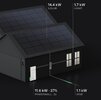Hi! I have a recently installed 12.7KW system with two PW+. I’m getting only about 6.2-6.3KW peak production in full sun and the system is producing about 40KWh daily.
I know those numbers are low and I contacted my installer which came to check the installation but couldn’t figure out the issue.
Does anyone have any ideas what may be causing the low values. I have 4 string coming down the roof, two for each inverter.
I know those numbers are low and I contacted my installer which came to check the installation but couldn’t figure out the issue.
Does anyone have any ideas what may be causing the low values. I have 4 string coming down the roof, two for each inverter.




